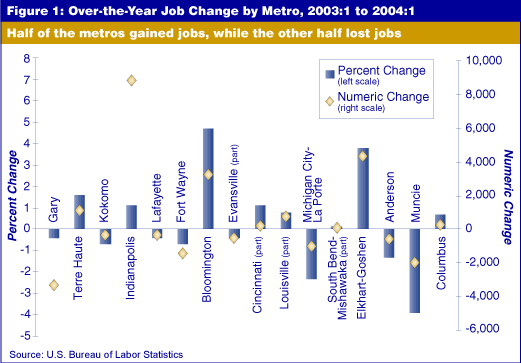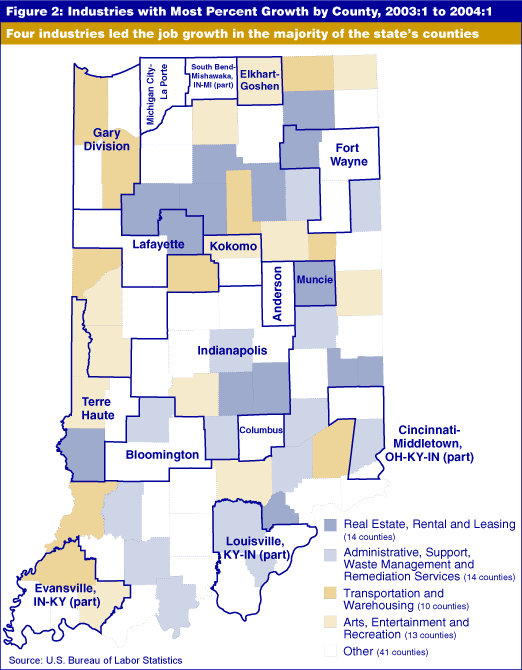Indiana's Employment Versus the Nation: Where We Have Been
To figure out where the job picture is heading, it is useful to look at past trends. This article examines job numbers from the Quarterly Census of Covered Employment and Wages (QCEW), which is produced by the Indiana Department of Workforce Development in cooperation with the Bureau of Labor Statistics. The QCEW data are universe counts derived from administrative files of employees covered by unemployment insurance (UI). Since the Current Employment Statistics (CES) program benchmarks their estimates annually to these universal counts, we will first examine the QCEW and then move forward to look at the job estimates.
In 2004:1, Indiana had 2,782,922 jobs, which is a decline of 62,518 jobs from the corresponding quarter of 2001. Table 1 shows over-the-year first quarter employment changes for the state and the nation. For the first quarter of 2004, Indiana had a job gain of 6,428 or 0.2 percent over the same period in 2003. This was a move in the right direction, but the national results outstripped our gain by 0.4 percentage points.
A job gain is always positive, but the situation would be better if those gains were evenly distributed. However, in this case, there were industry winners and losers. Not surprisingly, the manufacturing industry posted the largest nominal loss (-11,493 jobs), a 2 percent drop. Manufacturing was also a loser on the national level with almost 500,000 jobs lost (-3.4 percent). The service sectors, particularly health care and social services, compensated for the loss in manufacturing jobs with gains exceeding 6,500 jobs.
Metros and Counties
In terms of numeric job change, the 16 metropolitan areas (looking at just the Indiana portions) split in job gains and job losses from the previous year. The Indianapolis metropolitan area had the largest numeric increase in jobs (8,816), but did not stand out as a leader in job generation like the Bloomington (4.7 percent) and Elkhart-Goshen (3.8 percent) metro areas (see Figure 1).

Which industries are at the forefront of these employment increases? Figure 2 shows the sectors with the largest employment percent changes from 2003:1 to 2004:1 by county. Considering the percent change in jobs levels the playing field between small and large industries so we can examine how industries performed relative to others. Almost a third of Indiana’s 92 counties experienced the largest percentage growth in jobs in administrative, support and waste management services or real estate, rental and leasing. One-fourth of our counties experienced large percent increases in the arts, entertainment and recreation sector or the transportation and warehousing sector. The transportation and warehousing sector outperformed all other sectors in the Gary metro area, with a job gain of 1,078 (11 percent). The Lafayette metro area’s industry with the largest percentage change was agriculture, forestry, fishing and hunting (80 jobs, or 18.1 percent), although health care and social services had the largest nominal increase (276 jobs, or 3.2 percent).

Where We Are Headed
November 2004 preliminary job estimates were pegged at 2,947,400 (not seasonally adjusted), a gain of 16,900 jobs when compared to levels for November 2003. The nation experienced a 2.1 million increase in the number of jobs over the same time period. For the 11 months of 2004 for which data are available, Indiana has posted job gains every month and had a net increase of 162,700 jobs. Hopefully, the state can keep the momentum going.
Amber Kostelac
Data Manager, Indiana Business Research Center,
Kelley School of Business, Indiana University

